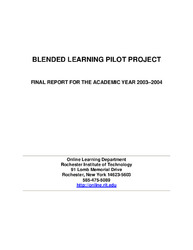| dc.description.abstract | Blended Learning aims to join the best of classroom teaching and learning with the best of online teaching and learning. Interest in Blended Learning is growing, as more and more universities get accustomed to using a courseware management system, and as academic leaders increasingly endorse active learning and the effective use of instructional technology. Consequently, more and more universities are making Blended Learning (also known as hybrid, mixed-mode, or distributed learning) a regular option for teaching and taking courses. Alert to these early national trends, and prepared to build upon 25 years of experience in Distance Learning, RIT’s Online Learning Department initiated a Blended Learning Pilot Project in fall 2003. In its first year, the Blended Pilot included 26 courses taught by 25 faculty members; approximately 550 students were enrolled in these courses. All courses used the myCourses course management system. Major findings include the following: 1. Nearly 75% of all students in the pilot indicate they like the Blended Learning format and feel just as strongly that other students should be able to take a Blended course. 2. Course completion is excellent—less than 5% withdrew or failed the courses. 3. Students perceive they have both a greater amount of interaction and a greater quality of interaction with other students. 4. Survey comments reveal that students were excited by the relatively large number of instructional strategies used in Blended courses. 5. Faculty participants say they are energized, even renewed, by the creative process of redesigning and teaching their courses in a new format. 6. Students would like to know ahead of time that a course is being offered as a Blended course. In sum, findings from the 2003-2004 Blended Pilot strongly suggest that Blended Learning is a viable alternative delivery method for the majority of RIT courses. In supporting the Blended Pilot, RIT remains both a national leader in the effective use of technology for teaching and learning, and a pioneer in identifying the right mix of face-to-face and online communication practices that will enhance learning effectiveness. In light of the above findings, we offer the following recommendations: 1. The Pilot should be continued and also enlarged for 2004-2005, with the goal of recruiting 50 new faculty participants. As in the first year, faculty should be offered a one-time stipend of $500 for participating in the Pilot. 2. Faculty from the first-year Pilot should be invited to participate in the 2004-2005 Pilot and receive full instructional design and research support. 3. Additional guides for Blended faculty and students should be developed. 4. A formal process for identifying and tagging Blended courses should be developed and disseminated to colleges, scheduling officers, and faculty. | en_US |

